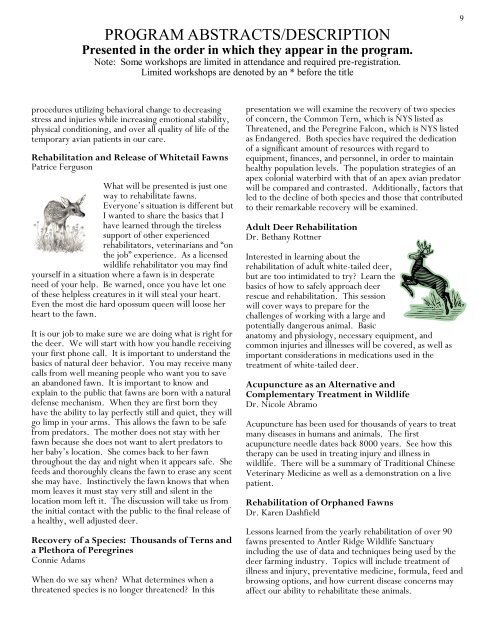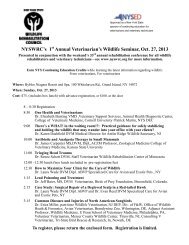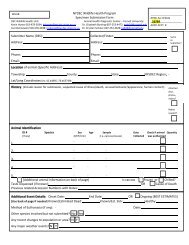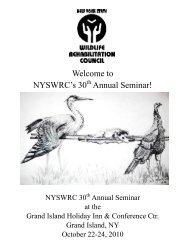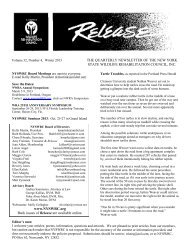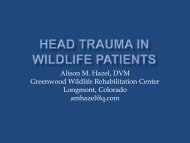Conference Booklet - New York State Wildlife Rehabilitation Council
Conference Booklet - New York State Wildlife Rehabilitation Council
Conference Booklet - New York State Wildlife Rehabilitation Council
You also want an ePaper? Increase the reach of your titles
YUMPU automatically turns print PDFs into web optimized ePapers that Google loves.
PROGRAM ABSTRACTS/DESCRIPTION<br />
Presented in the order in which they appear in the program.<br />
Note: Some workshops are limited in attendance and required pre-registration.<br />
Limited workshops are denoted by an * before the title<br />
9<br />
procedures utilizing behavioral change to decreasing<br />
stress and injuries while increasing emotional stability,<br />
physical conditioning, and over all quality of life of the<br />
temporary avian patients in our care.<br />
<strong>Rehabilitation</strong> and Release of Whitetail Fawns<br />
Patrice Ferguson<br />
What will be presented is just one<br />
way to rehabilitate fawns.<br />
Everyone’s situation is different but<br />
I wanted to share the basics that I<br />
have learned through the tireless<br />
support of other experienced<br />
rehabilitators, veterinarians and “on<br />
the job” experience. As a licensed<br />
wildlife rehabilitator you may find<br />
yourself in a situation where a fawn is in desperate<br />
need of your help. Be warned, once you have let one<br />
of these helpless creatures in it will steal your heart.<br />
Even the most die hard opossum queen will loose her<br />
heart to the fawn.<br />
It is our job to make sure we are doing what is right for<br />
the deer. We will start with how you handle receiving<br />
your first phone call. It is important to understand the<br />
basics of natural deer behavior. You may receive many<br />
calls from well meaning people who want you to save<br />
an abandoned fawn. It is important to know and<br />
explain to the public that fawns are born with a natural<br />
defense mechanism. When they are first born they<br />
have the ability to lay perfectly still and quiet, they will<br />
go limp in your arms. This allows the fawn to be safe<br />
from predators. The mother does not stay with her<br />
fawn because she does not want to alert predators to<br />
her baby’s location. She comes back to her fawn<br />
throughout the day and night when it appears safe. She<br />
feeds and thoroughly cleans the fawn to erase any scent<br />
she may have. Instinctively the fawn knows that when<br />
mom leaves it must stay very still and silent in the<br />
location mom left it. The discussion will take us from<br />
the initial contact with the public to the final release of<br />
a healthy, well adjusted deer.<br />
Recovery of a Species: Thousands of Terns and<br />
a Plethora of Peregrines<br />
Connie Adams<br />
When do we say when? What determines when a<br />
threatened species is no longer threatened? In this<br />
presentation we will examine the recovery of two species<br />
of concern, the Common Tern, which is NYS listed as<br />
Threatened, and the Peregrine Falcon, which is NYS listed<br />
as Endangered. Both species have required the dedication<br />
of a significant amount of resources with regard to<br />
equipment, finances, and personnel, in order to maintain<br />
healthy population levels. The population strategies of an<br />
apex colonial waterbird with that of an apex avian predator<br />
will be compared and contrasted. Additionally, factors that<br />
led to the decline of both species and those that contributed<br />
to their remarkable recovery will be examined.<br />
Adult Deer <strong>Rehabilitation</strong><br />
Dr. Bethany Rottner<br />
Interested in learning about the<br />
rehabilitation of adult white-tailed deer,<br />
but are too intimidated to try? Learn the<br />
basics of how to safely approach deer<br />
rescue and rehabilitation. This session<br />
will cover ways to prepare for the<br />
challenges of working with a large and<br />
potentially dangerous animal. Basic<br />
anatomy and physiology, necessary equipment, and<br />
common injuries and illnesses will be covered, as well as<br />
important considerations in medications used in the<br />
treatment of white-tailed deer.<br />
Acupuncture as an Alternative and<br />
Complementary Treatment in <strong>Wildlife</strong><br />
Dr. Nicole Abramo<br />
Acupuncture has been used for thousands of years to treat<br />
many diseases in humans and animals. The first<br />
acupuncture needle dates back 8000 years. See how this<br />
therapy can be used in treating injury and illness in<br />
wildlife. There will be a summary of Traditional Chinese<br />
Veterinary Medicine as well as a demonstration on a live<br />
patient.<br />
<strong>Rehabilitation</strong> of Orphaned Fawns<br />
Dr. Karen Dashfield<br />
Lessons learned from the yearly rehabilitation of over 90<br />
fawns presented to Antler Ridge <strong>Wildlife</strong> Sanctuary<br />
including the use of data and techniques being used by the<br />
deer farming industry. Topics will include treatment of<br />
illness and injury, preventative medicine, formula, feed and<br />
browsing options, and how current disease concerns may<br />
affect our ability to rehabilitate these animals.


